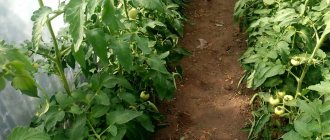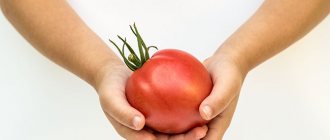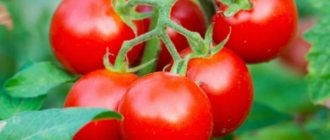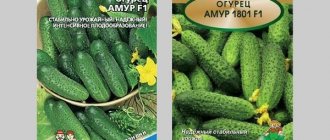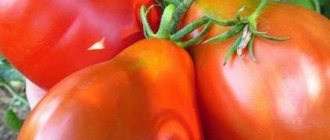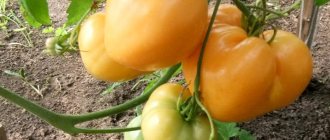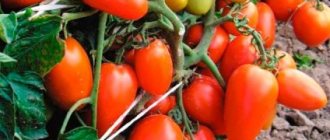The world of nightshade crops is amazing and rich. Tomato is a favorite vegetable of gardeners. But, unfortunately, the crop is often “eaten up” by late blight. And probably, every summer resident wants to grow a tomato that would not be affected by any disease. “Dreams,” you say. But no, it exists! One of our rarest crops is the tsifomandra, or tomato tree. In our article we will talk about growing tomato tree cyphomandra.
Description of the tomato tree variety Cyphomandra
Cyphomandra is a shrubby tree belonging to the nightshade family. Otherwise it is called tomato or tammarillo. Attracts with its tart taste. The fruits have a red-orange hue and a hard peel that is unsuitable for food. Black varieties are available. The pulp itself is very juicy. The leaves reach 35 cm in length and have a pointed five-pointed shape. In our country, tammarillo is most often planted in greenhouse conditions or in tubs. Color and taste depend on the variety. The red and purple fruits are similar in taste to tomatoes, the rest have a sweet taste. They grow in clusters. There are up to 15 pieces on each of them.
Characteristics and description
Description of the bush
The tomato tree "Cyphomandra" exactly lives up to its name.
- It looks like a tree: at first the trunk grows quickly, becomes woody below, and a crown of shoots forms at the top. It is formed in the same way as in real trees.
- The trunk of an adult tree reaches a diameter of five to eight centimeters, and branches - up to 3 cm.
- The tree looks impressive: it decorates any garden, greenhouse, veranda and apartment where it grows in large containers.
- The tomato tree is decorated with large beautiful leaves and bright fruits.
- It is afraid of low temperatures: even with a short-term drop to +2 °C, it sheds its leaves and young shoots die, but after the temperature rises, it gains strength again, so it is recommended to grow in heated greenhouses or only until autumn.
- It loves the sunny side, does not develop in the shade and does not reach large sizes.
Description of fruits
The fruits of the “Tsifomandra” variety bear little resemblance to tomatoes. They most likely resemble exotic fruits.
- They have an unusual flesh color. It can be dark, bluish with a red skin, or yellow with an orange top.
- The fruits themselves are distinguished by a variety of colors: pink-raspberry, red, yellow, olive, lemon and beet-like. There are so many varieties, so many colors.
- The pulp is juicy, has an interesting exotic taste, but pleasant, with hints of fruit: passion fruit, lemon, strawberry and tomato.
- The fruits look like large plums or an egg, hanging on a long stalk. They grow from several to twenty pieces in a cluster. Their size is approximately 5 cm wide and up to 10 cm long. The weight of one fruit is from 30 to 50 g.
- The skin of the fruit is hard, tasteless, and bitter.
Advice! They only eat the pulp, as the skin is bitter! Therefore, this fact must be taken into account when preparing dishes. How to eat fruit correctly? Cut it in half and eat the soft core with a spoon.
And in order to use the whole fruit for food, it is necessary to remove the skin from it. To do this, the fruits are scalded with boiling water, kept in it for about a minute, after which the skin can be easily removed.
- Peeled fruits are widely used in cooking. They are used to prepare salads, purees, mousses, everything that is made from real tomatoes, as well as sweet desserts: jams, marmalade, decorating sponge cakes and ice cream. You can marinate like regular tomatoes.
- They are perfectly stored frozen, preserving all the beneficial properties and vitamins that this fruit contains in abundance: B vitamins, vitamins A and C, PP, potassium, magnesium and other trace elements.
How does Cyphomandra tomato tree reproduce?
Cyfomandra tomatoes are most often propagated by seeds. However, there is another way - vegetative. The varieties that you especially like can be propagated from green cuttings. Already in the first year after such propagation, you can harvest the crop and even take the tomato tree to a greenhouse or garden for a while. After fruiting, many gardeners destroy most plants. For growing from cuttings, one-year or two-year-old branches no more than a centimeter in thickness and no more than forty-five centimeters in length are suitable. Cuttings help to grow a bushy but compact plant, its branches are located low, and varietal characteristics are preserved much better with this method. Even in simple boiled water they will take root perfectly.
Advantages and disadvantages
You found out what kind of fruit this “tsifomandra” tomato is, its characteristics and description of the variety, now let’s look at all the advantages and disadvantages of this plant.
Let's consider the advantages of the tomato tree.
- High-yielding, from one tree you can collect from 20 to 30 kg of fruit in a season that lasts seven months.
- Exotic fruits of unusual taste, good for health: there are no contraindications, as they have low calorie content, without fats and carbohydrates. Unlike other fruits, they can be consumed even by people with diabetes.
- The plant looks decorative and is a decoration for any greenhouse and garden.
- Propagates well by seeds and cuttings.
- Can be grown at home, on the loggia and in the winter garden all year round.
- Almost never gets sick.
- It can grow on a glassed-in loggia in a pot if it faces south.
What can be attributed to the disadvantages of the tsifomandra tomato, guided by the description of the variety.
- If you celebrate its large harvest, then you should not forget about the area this tomato tree occupies, and, recalculated in square meters, you can doubt the yield.
- It bears fruit only in the second year: this means that it is relatively suitable for our gardeners. The tree will have to be moved indoors for the winter, if there is no heated greenhouse, it will have to be looked after all winter and taken out to the site in the spring.
- When transplanting or transporting home from open ground for the winter, you don’t have to expect a high yield. It should be treated simply as an exotic plant.
- The fruits fall off when ripe, so it is important to remove them from the tree in time.
- Fruits cannot be stored: maximum two weeks if refrigerated.
- The tree is demanding on temperature conditions: at low temperatures it sheds leaves and flowers, so in winter greenhouses and loggias the temperature must be maintained at least 10–15 °C.
- As it turned out, the digital tomato still has more disadvantages, although its reviews and photos are very attractive and tempting for people.
How to grow a tomato tree Cyphomandra from seeds
Tomato, which has positive reviews, can be grown from seeds. This is the most reliable way. Especially if the planting material was purchased from a trusted place. The growing process itself is carried out in several stages: Before planting, the seeds of the plant must be washed in a weak solution of potassium permanganate and in water. After this, experts recommend drying the planting material at room temperature and only in the shade. To speed up the germination process, seeds should be placed for 24 hours in a place where the temperature will be maintained at a fairly low temperature. One of the shelves in the refrigerator is ideal for this. While the planting material is being prepared, it is worth mixing the soil. A mixture of river sand and peat is ideal for this type of tomato. The soil should be light and airy. Tomato seeds are sown in rows, with a gap of at least 60 centimeters between them. It is also recommended to leave space between planting materials. In this case, the distance between the seeds should be at least 30 centimeters. The seedlings should be transplanted into open ground at the end of May.
Features of cultivation
Tomatoes of the Cyfomandra variety can be grown in seedlings or propagated by cuttings. It is recommended to disinfect seeds for seedlings in a solution of potassium permanganate, rinse with clean water, and dry.
The soil should be light. A mixture of garden soil with peat and a small portion of washed river sand is preferable. With the seedling method, the seeds are sown slightly deeper, sprayed with water, and then placed in a warm place for germination. You can use growth stimulants and special mini-greenhouses.
Seedlings require room temperature, bright light, and moderate watering with warm water . It is better to use a spray bottle or watering can. After the first true leaves appear, the tomatoes are planted in separate pots. Seeds can be sown in individual peat containers, then picking is not required.
In the second half of May, tomatoes are transplanted into open ground, a greenhouse or flowerpots. By this time, the seedlings should have grown stronger, preferably the appearance of 6-7 true leaves and the first flower clusters. The soil is mixed with a fresh portion of humus, the plants are placed at a distance of 50 cm from each other. If tomatoes are planted in pots, you need to take care of drainage holes and trays in advance. Read how to prepare the soil in a greenhouse here.
Tall bushes are tied to supports, side shoots are pinched off, they are suitable for rooting. Adult plants are fed with complex fertilizer based on phosphorus and potassium at least once a month. Watering is moderate, only with warm water; periodic spraying and mulching are useful to maintain soil moisture.
Growing a tomato tree in a greenhouse
These tomatoes also grow well in greenhouses. Full cultivation and fruiting of the Sprut f1 variety is carried out only in hydroponics. This is how the tomato tree and its fruits will be protected from diseases and pests that can certainly appear during such a long growing period.
Considering the genetics of the plant for intensive growth and dense branching, this plant simply needs good lighting, proper care and nutrition. You can grow a tomato tree Sprut f1 in both an amateur and a professional greenhouse. This should be a year-round heated room with artificial lighting. To plant such a giant, it is recommended to take a larger container - with a capacity of 1 to 2 m2, with a height of at least 50 cm. Many gardeners use an old bathroom for this purpose. In addition, you will need a lid that will protect the nutritional components from overheating in the summer, as well as a spacious container for preparing nutrient solutions.
Useful articles for gardeners and gardeners
Care
Many summer residents are afraid to purchase new, and especially rare varieties of tomatoes, for fear of too complicated care. It’s such a shame if all your work is in vain, if you fail to harvest the harvest. However, the Tsifomandra variety does not belong to the category of difficult-to-cultivate tomatoes. Even though they are tall, they are no more difficult to care for than tomatoes, which grow much shorter. It is important to know and remember that the amount of harvest will depend on how the process of cultivating the land and bushes occurs. If agricultural practices are carried out correctly, the number of fruits can be doubled.
Basic rules of agricultural technology:
- Tomatoes love to drink, but they need to be watered properly. For the first time after transplantation, tomato bushes are watered only after 10-14 days. If you start watering immediately, the fragile roots will not have time to absorb moisture. The roots will simply begin to rot. In addition, further waterlogging of the soil will lead to a delay in the development of plants and delay the moment of fruiting. In addition, strong humidity is fraught with the occurrence of fungal diseases, which are very difficult to get rid of. Bushes need especially a lot of water during flowering and fruiting. Each bush should take up to 5 liters of warm, settled water daily.
- To ensure that water remains in the soil longer, the ground under the bushes is mulched. Straw, sawdust, and old grass act as mulch. Overheated mulch will decompose and thereby nourish the roots of the tomatoes. Mulch reliably protects the roots from overheating, less weeds grow under it, and the number of waterings can thereby be reduced.
- All tall tomatoes need to be shaped. It is better to keep the tsifomandra in one or two stems. It is advisable to leave 1 or 2 stepsons located under the first inflorescence. They will serve as stems - brushes will form on them, on which fruits will grow. Pruning must be done until the length of the sprouts exceeds five centimeters, otherwise the plant will be more difficult to survive removal.
Advice
: pruning of side shoots should be done in sunny, warm weather early in the morning, so that all wounds have time to dry out during the day. The removal procedure must be done manually without using a tool.
- It often happens that large double flowers appear at the top of plants; their appearance indicates that the plant development process is not going well. Perhaps the bush receives too much water or the external temperature changes too often. Such flowers should be removed immediately, as they produce ugly fruits. Such fruits require a lot of nutrition, which they will take from other ripening fruits.
- The lower leaves located at the very bottom of the stem are removed. They greatly shade the area under the bush, so moisture can accumulate there or pathogenic microflora can develop. All yellowed and tired leaves are also removed. Non-fruiting brushes are also removed. Only 2-3 leaves are removed at a time. The removal procedure should be carried out once a week.
It is important to focus not on the quantity of fruits, but on their quality. Therefore, during flowering, you can remove excess inflorescences. The remaining ones will grow into large and juicy fruits.
note
: the more flowers, the more fruits. But small in size.
It is important to build a reliable support immediately after planting the tomatoes. Cyphomandra bushes sometimes grow up to two meters high, and therefore require constant garters. It is best to use a trellis for this purpose and tie bushes to it every 30 centimeters of their growth.
- It is necessary to help the bushes to self-pollinate. To do this, you need to shake the branches and then sprinkle the air with water so that the pollen settles.
- Those fruits that managed to set before the beginning of August will have time to ripen in time, before the onset of night frosts. To help them ripen on time, you need to pinch the top of the plant 40 days before harvest, thereby stopping its growth. This will result in a redistribution of nutrition - it will be used to fill the fruit.
- For rapid growth of tops and fruits, plants constantly need additional nutrition. Tomato bushes need to be fed at least three times per season. The first fertilizers are applied two weeks after planting in the garden. Initially, plants need nitrogen, so nitrogen-containing substances are added to the soil along with organic fertilizers. When the second cluster of flowers blooms, it’s time for the second refill. For plants, a composition is prepared from complex fertilizer “Solution” or “Kimera universal”, copper sulfate and potassium permanganate. Up to two liters of nutrient mixture are consumed for each bush. The third feeding is carried out during intensive fruiting. Fertilizers will be needed to give the fruits juiciness and taste. The composition of the feed is the same as in the second feed.
Gardeners recommend irrigating the bushes with a solution of boric acid to enhance fruit growth and reduce flower falling. And to speed up the fruit set, add a little iodine to the water for irrigation. Cyphomandra bears fruit from August to October. In the last month, tired plants are released from their bindings and laid out on the ground. During this period, fruit ripening occurs. There is no need to water the bushes anymore. Since frosts may occur at the beginning of October, which can freeze the fruits, it is advisable to cover the bushes with a protective cloth at night.
Caring for a tomato tree
The variety needs long daylight hours, so it is advisable to provide the plant with lighting at night. Systematic feeding with fertilizers that contain potassium and phosphorus will be useful. Watering needs to be moderate, it is advisable to use spray bottles and periodically spray the plants. Yellowing leaves need to be cut off. Stepsonning will also be useful. Caring for “Digital Mandra” will require some attention and effort.
Features of agricultural technology
Since digitalis belongs to the Solanaceae, it is grown according to the rules that are relevant for other crops of this family. Choose a south or southeast facing position. Prepare a wide, but not too deep pot, since the root system of Cyphomandra is superficial. A tray and drainage are required.
Advice. In winter, add additional lighting to the digital display and maintain the room temperature at +15...+18 °C.
The soil for a tropical plant should be light and fertile. For example, a mixture of humus, peat and sand (2:1:1) is suitable. Seeds are sprouted in early spring, planted to a depth of 1 cm. Sprouts with two leaves are planted, and after a couple of weeks they are first fed with a mineral composition. In the future, fertilizers are applied twice a month, alternating phosphorus and potassium mixtures. It is better to water the tsifomandra not at the root, but in the pan.
Tamarillo is planted in a permanent place in a pot or garden at the 7-8 leaf stage. If flowers appear on the plant in the first year, they should be cut off. This way you will form a strong tree. The fact that Cyphomandra is preparing to bear fruit is evidenced by the abundant branching of the crop.
Advice. To propagate tamarillo from cuttings, use the top shoots of the first two years. The thickness of the branches should be from 1 cm, and the length should be 40-45 cm.
Diseases and pests of tomato tree cyphomandra
The tomato variety Cyfomandra is resistant to most dangerous diseases: fusarium, verticillium, tobacco mosaic, leaf spot. For prevention, the soil is calcined or disinfected with a solution of potassium permanganate before planting. Loosening the soil and spraying the plantings with non-toxic biological preparations will help prevent fungal diseases. Plants can be affected by aphids, thrips, whiteflies, and spider mites. For prevention, you can spray the bush with a weak solution of potassium permanganate; in advanced cases, industrial insecticides will help. Tomatoes of the Tsifomandra variety are an interesting find for the garden, greenhouse or apartment. They are real champions in terms of productivity, and the extended fruiting period will help provide the family with vitamins for a long time.
Description and characteristics of the Tsifomandra tomato, reviews, photos
Medium-sized, mid-ripening, productive tomato variety for greenhouses and open ground.
The bush is slightly leafy, with thin leaves, about 1 meter high . Requires tying to the support and pinning.
Basic qualities of fruits
The tomatoes are heart-shaped, pink-raspberry in color, weighing 150-300 grams , very tasty and aromatic. The pulp is fleshy, sweet, with few seeds. These tomatoes are good for fresh consumption, making juices and sauces.
There is a variety from the Siberian Garden that has exactly the same name. Their description from the pack: mid-season variety, bush height 1-1.5 meters. Tomatoes up to 800 grams, heart-shaped, pink-red, tasty, fleshy. That is, it is a slightly different variety. The one we are describing can be called Cyphomandra bush.
Productivity of Cyfomandra tomatoes : up to 3 kg of fruit from 1 plant (subject to agricultural practices).
What do you eat tamarillo-cyfomandra with?
Not a direct match for tomato, but something similar. And he doesn’t suffer from tomato diseases either! You can, of course, use the fruits like tomatoes, but you must admit that it’s just not interesting! Interesting recipes using tamarillo—that’s what the tsifomandra is called in retail chains—are found in South American cuisines, as well as in Australian and New Zealand. Moreover, different varieties work in different ways - both as fruit in dessert compositions, as components and independent side dishes for second courses, and raw materials for compotes and jams. That’s how you hear it: Pampering!.. And didn’t they say the same thing about potatoes three hundred years ago?
Growing Cyfomandra tomatoes
Like most other varieties of tomatoes, Cyphomandra is grown through seedlings. Sowing seeds for seedlings is carried out approximately two months before planting the seedlings in the garden bed, that is, in most regions in the second half of March. Caring for seedlings involves the usual procedures. It is important not to let the seedlings stretch out, for which they spend the first week at a temperature not exceeding 16 ° C and in bright light. In the future, the temperature should be maintained at about 20 ° C during the day and slightly lower at night. Feeding seedlings is carried out only if growth slows down. A week before planting in the garden, hardening is mandatory.
There are no more than four plants per square meter of beds, and preferably only three. Bushes are formed into one or two stems, the remaining stepsons are systematically broken out, especially in regions with a not too warm climate. Tying is carried out as the fruit grows; The largest tomatoes sometimes require individual supports. If, during the ripening of the bulk of the fruit, the bush continues to grow and new flowers appear, the crown is pinched and the flowers are torn off.
The variety requires abundant watering, which is reduced only when the tomatoes begin to ripen. In normal weather, each bush may require a bucket of water weekly, and in drought, more. Fertilizing is given every two weeks: first, mullein infusion or complete mineral fertilizer, and during the fruit-filling phase, they are limited to ash infusions.
High yields cannot be obtained without fertilizing
Cyphomandra, tamarillo and other names of the same plant
Tomato tree is a beautiful name for a unique fruit-bearing plant that has become increasingly confusing lately.
The tomato tree was originally called beetroot tree (Cyphomandra betaceae). But the appearance of the commercial name tamarillo in New Zealand (a trademark derived from the Maori words for “superiority” and “yellow”), and then the official recognition of beetroot tamarillo (Solanum betaceum) as an independent species of plant from the Solanaceae family, radically changed the situation. After all, the status of the digital figure itself remained “unresolved”. There is a lot of debate about the status of digitomandras and the need for their reclassification from a separate species into tamarillo (or vice versa), a possible complete change of names. In the meantime, scientists have not decided and the plant continues to be studied, it is worth remembering that tsifomandra, tamarillo, tamamoro, and even octopus are all names of the same plant, which remains original, large, fruitful and special in everything.
There is even more confusion with regular tomatoes. One of the large varieties of tomatoes bearing fruit with stunning clusters received its name in honor of Cyphomandra, but we are talking about classic tomatoes that bear fruit in the year of sowing, and not at all about a perennial fruit tree.
The best option is not to pay so much attention to the name, but to the characteristics of the plant, because real tomato trees are certainly different from tomatoes, they are perennial, with different fruits and are difficult to confuse with something else.
Cyphomandras are especially popular in countries with subtropical and tropical climates, where their fruiting can be enjoyed all year round. This plant migrated to us from Southern Europe and the Americas, where commercial plantings can boast a special scope in the territories of Brazil. It is believed that the European history of digital figures began only in the last century and we owe its status as a fashionable culture, first of all, to the French.
Indoor digitalis grows to a maximum of 2.5 meters. Maja Dumat
Features of care
Octopus f1 requires care, which consists of watering and fertilizing.
In addition, it is necessary to take all measures to prevent diseases and control insect pests.
This is especially necessary, since a common disease or pests that have already appeared are much more difficult to eliminate.
Working with soil
Caring for a tomato tree in open ground must necessarily include loosening the soil. This should be done approximately 2-4 times per season.
A crust sometimes forms on the surface of the earth, which prevents the rapid penetration of moisture and oxygen into the soil.
It often appears after rains and watering. Loosening helps remove this crust.
The first time the procedure is carried out 10 days after the seedlings are transplanted into open ground.
Feeding and watering
It is impossible to grow a tomato tree and get a good and high-quality harvest without regular watering and timely fertilizing.
Mineral and organic fertilizers are used.
Professional gardeners recommend fertilizing every 3-4 days during the growing season.
For the development of a hybrid, the following microelements are necessary:
- boron;
- iron;
- zinc;
- nitrogen;
- potassium;
- manganese;
- phosphorus.
The first application of fertilizers is the beginning of summer. Plants are also fertilized with mullein and ammonium nitrate.
The regularity of watering is from 2 to 4 times a week. At least 1 bucket of water is poured onto each plant.
During rainy summers, watering is reduced. During particularly hot and dry summers, you need to navigate by the condition of the soil. If it is too dry, it needs to be watered every day.
Stepsoning
The tomato tree Octopus f1 does not need this procedure. Although some gardeners argue that pinching is necessary.
However, without it, the hybrid is able to produce a better harvest. In addition, pinching leads to a decrease in yield.
Treatment
Treatment is required to enhance the development of the plant. Sometimes it happens that it begins to grow more slowly, and the ripening of fruits slows down.
A special spray solution will help. You can prepare it yourself:
- Pine shoots are placed in the freezer for several weeks.
- If necessary, take it out and pour boiling water over it.
- Keep in a hot rein for about 30 minutes.
- Strain everything carefully.
- For spraying you need to dilute it in a ratio of 1:3.
The solution is used during the formation of buds on the plant. In addition, so that the hybrid is no more than 3-4 m, its top is shortened.
It is necessary to get rid of dry and damaged leaves in a timely manner. To prevent the spread of diseases and pests.
Growing conditions for indoor digitalis
Cyphomandra is difficult to grow; it is a large, demanding plant and not for everyone. It can be cultivated as an indoor plant, greenhouse plant, greenhouse wood plant, or as a garden planter with wintering indoors.
They are increasingly trying to grow Tamarillo in open ground as an annual, throwing out the plant after the arrival of frost, with the annual cultivation of seedlings or preliminary cutting and rooting of cuttings for the next year. Seeds of hybrid tamarillos capable of bearing fruit in the first year are sown as seedlings along with tomatoes, subsequently resorting to similar cultivation tactics.
Beetroot Cyphomandra (Cyphomandra betaceae). Parchen
Lighting and placement
This is a sun-loving plant, for which, while maintaining compactness at an early age, only places on window sills are suitable, and when it reaches its true size, as close as possible to the windows. The brightest places in the house are the only option for a digital man.
Digitomandras will prefer partially southern windows to eastern and western windows. They grow well in the southeast, but any maximally bright window in the house is quite suitable for them. They can be placed near observation windows, on heated balconies and loggias.
Tomato trees in winter, or rather from mid-autumn, especially if fruiting continues, it is advisable to provide additional lighting, increasing not so much the light intensity as the duration of daylight hours, at least up to 11 hours. Lack of additional lighting leads to the loss of some fruits and foliage.
When choosing a place for tamarillo, you should consider its dimensions. They require a lot of space, the leaves emit an unpleasant odor, and the fragile shoots do not tolerate unnecessary contact, so they are placed only in large rooms, away from places of rest and active pastime, where the tomato tree can develop freely.
Temperature and ventilation
Digitomandras feel great in the summer at any temperature above 20 degrees Celsius. The main difficulties are associated with the cool wintering of the plant. To preserve the leaves and continue fruiting, you need to maintain a temperature of at least 15 degrees.
If the plant has entered the dormant stage, it is transferred to cool conditions - but within 12-15 degrees Celsius. The minimum temperature that digitalis can withstand is 2 degrees Celsius, and after the temperature drops below 10 degrees, the plant sheds its leaves and stops growing.
True, it is worth considering that even short negative temperatures usually do not cause the death of the plant, and although it suffers greatly, it is able to recover if conditions are quickly corrected.
In summer, the tomato tree feels better in the fresh air or at least with regular ventilation. In the garden it grows more actively and bears fruit better. When placing tamarillo outdoors, you should make sure that the place is protected from drafts and has good lighting. You can transfer plants into the ground, dig in containers, and simply display them on sites.
Cyphomandra abutiloides. Linda De Volder

